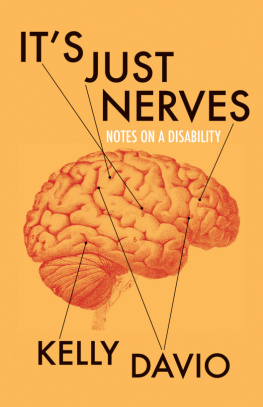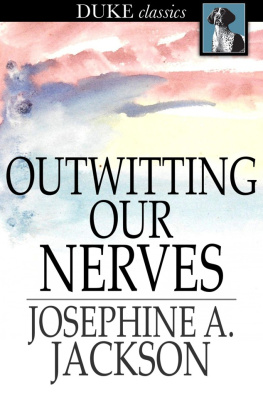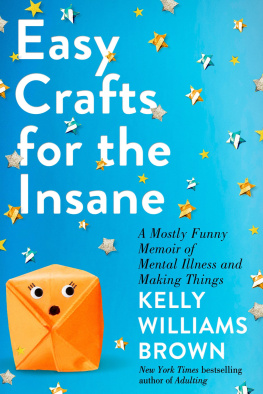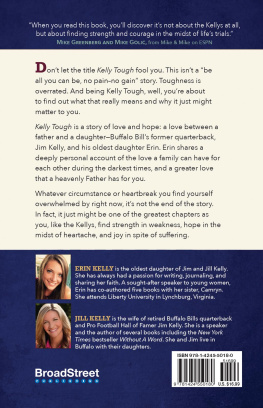ITSJUST NERVES
notes on a disability
KELLYDAVIO
SQUARES & REBELS
Minneapolis, MN
***
ALSOBY THE AUTHOR
Burn This House
***
COPYRIGHT
Its Just Nerves: Notes on a Disability.
Copyright 2017 by Kelly Davio.
Cover Design: Edwin Smet
Photograph: Adrianne Mathiowetz
SMASHWORDS LICENSESTATEMENT
This ebook is licensed for your personal enjoymentonly. This ebook may not be re-sold or given away to other people.If you would like to share this book with another person, pleasepurchase an additional copy for each reader. If youre reading thisbook and did not purchase it, or it was not purchased for your useonly, then please return to your favorite retailer and purchaseyour own copy. Thank you for respecting the hard work of thisauthor.
All rights reserved.No part of this book can be reproduced in any form by any meanswithout written permission. Please address inquiries to thepublisher:
Squares & Rebels
PO Box 3941
Minneapolis, MN 55403-0941
E-mail: squaresandrebels@gmail.com
Online: squaresandrebels.com
Printed in the United States of America.
A Squares & Rebels First Edition
***
CONTENTS
I. TheMirror
II.The Four White Walls
III. On Display
IV.The Wide World
Loss Report
***
for
Steve Cook
***
Those who be in trouble with a scarcity of spirits,are able at first rising in the morning to walk, move their armsthis way and that, or to lift up a weight with strength; but beforenoon, the stores of spirits which influenced the muscles beingalmost spent, they are scarce able to move hand or foot. I now havea prudent and honest woman in cure, who for many years has beenobnoxious to this kind of bastard palsy not only in the limbs, butlikewise in her tongue; this person for some time speaks freely andreadily enough, but after long, hasty, or laborious speaking, shebecomes mute as a fish and cannot bring forth a word, nay, and doesnot recover the use of her voice till after an hour or two.
first documented description of myasthenia gravis,by Thomas Willis in De anima Brutorum, 1672
***
I. THEMIRROR
***
STRONG IS THE NEWSEXY
In the hospital complex, I sit in a room with awoman who plans to teach me how to swallow. Or, to re-teach me. Iknew how to swallow just as I knew how to breathe. Its just that,somewhere along the way, my bodys muscles have forgotten.
The physical therapistholds a stethoscope to my throat and listens to me sip ice water.Some time later we move to applesauce, then to a dry and crumblingcracker. She makes notes on a clipboard, studies them.
On the other side ofthe plate-glass window of the physical therapy room, hang glidersswoop down from the pine-covered mountainside. Their sails are thebright neon of 1990s fashion, and its impossible to miss thedaredevils with their spectacular, spandexed bodies. I wonderwhether the location of the window is intended to be inspirational:a call to the possibilities of good health, a motivation to performones exercises well and get back out there. I have animpulse to drop the blinds over the window. Id like to occlude themountain.
I used to grade student papers in waiting rooms, butmy red pen and a sheaf of student essays invited too many commentsfrom otherswhere did I teach, what grade level, did I enjoy mywork. On such occasions, I prefer to keep my own counsel. I havedeveloped the habit of pulling out my smart phone and flippingmindlessly through applications, dissolving the minutes ahead of myappointments for which I always seem to arrive early.
I open an applicationcalled Pinterest. Its a perfectly innocuous, time-wasting servicethat shows me photos of things that my friends enjoy. I scrollthrough images of dogs lolling on grass, craft projects that no oneI know has the time or skill to complete, aspirational homerenovation schemes. My thumb whisks the world by at a clip or acrawl; I am all-powerful on this tiniest of screens.
Scrolling through thisarray of images, I know I run the risk of seeing it. I know that Ishould stop while my mind is full of photos of captioned housecatsand decorated cookies, but I scroll on. And there it is, a photo ofa gorgeous, well-fed, hourglass-figured girl stepping from theocean in a bandeau bikini. The caption that hovers below her, asthough emerging from the sand, reads: Being healthy and fit is somuch more important than being skinny.
The physical therapist lifts her head from her notesto tell me that she cannot assign me any exercises. Theyre veryeffective for most people, she says. Science has the data to proveit. Yet its the nature of my condition, she reminds me, that withattempts at repeated movement, my body will rush antibodies to thesite where nerve meets muscle, the immune system blocking theneurotransmitters. Repeated flexing will only make my musclesweaker. We are going to focus instead, she says, ontechnique.
She shows me how totuck my chin to my chest as I swallow. This will keep me fromaspirating my food, and from sucking water down my windpipe andinto my lungs. On a paper handout that has been photocopied manytimes over, its text grown fuzzy over time, she shows me across-section of the human chest, points to where food particlescan land in the bronchial tree, and explains that pneumoniaflourishes on their half-chewed surfaces.
She demonstrates howto hold my head at an angle as I chew, as though I were casuallyglancing over my shoulder as I masticate another cracker. Thisposture is meant to block the weaker side of my throat and keep mefrom choking. Its hard to imagine doing this at home on a regularbasis, much less making a go of this chin-tuck and shoulder-glanceattitude at a nice restaurant (whats that woman lookingat?) but I do as she asks.
The most importantthing, she tells me, is that I dont quit eating. Sometimes peoplejust give up, she says. She looks at my chart again, and asks howmuch weight Ive lost in the past few months.
The product of a generation of girls who grew upwith the specter of anorexia stalking our friends and siblings, Iwas told that real women have curves as though it were amantra.
Our elders weretrying. They wanted to flip the arbitrary concept of thin-bodybeauty on its ear. They wanted us to find self-acceptance, but whenthey tried to scare us with photos of undernourished bodies andcautionary tales of the dangers of disordered eating, we learnedthat being skinny was one more way in which we could failone moreway our bodies could be repellant.
With the onset of aprogressive neuromuscular disease several years ago, my bodysrelationship with solid food became a complicated one. I was nevera curvy woman to begin with, but with each of the more feminineattributes Ive lost, Ive become, I am given to understand, lessand less of a real woman.
I wonder at what pointI will become unreal altogether.
At first it was easy enough to cover for some of theeffects of my illness under the guise of sheer clumsiness. Idropped things, I stumbled, and sometimes I garbled my words, but Iwas never an elegant, balletic woman. Known for knocking overglasses of water or tripping over the smallest of cracks in thesidewalk, I was happy enough to chalk my bungled movements up toidiosyncrasy. For a couple of years I could pass for a realwoman.
By their nature, progressive diseases worsen overtime. I stopped breathing now and then. Chewing was a hit-and-missproposition. Sipping water became, at times, more trouble than itwas worth; to a weakened arm, a bottle of spring water is as hardto raise as a dumbbell.
I began to lackreality. I took to baggy tops and A-line silhouettes to hide mypoking collarbone, my meatless hips. I took up as much space as Icould in bulky sweaters. I compensated for my diminishing realityby covering over my negative space.
Next page










